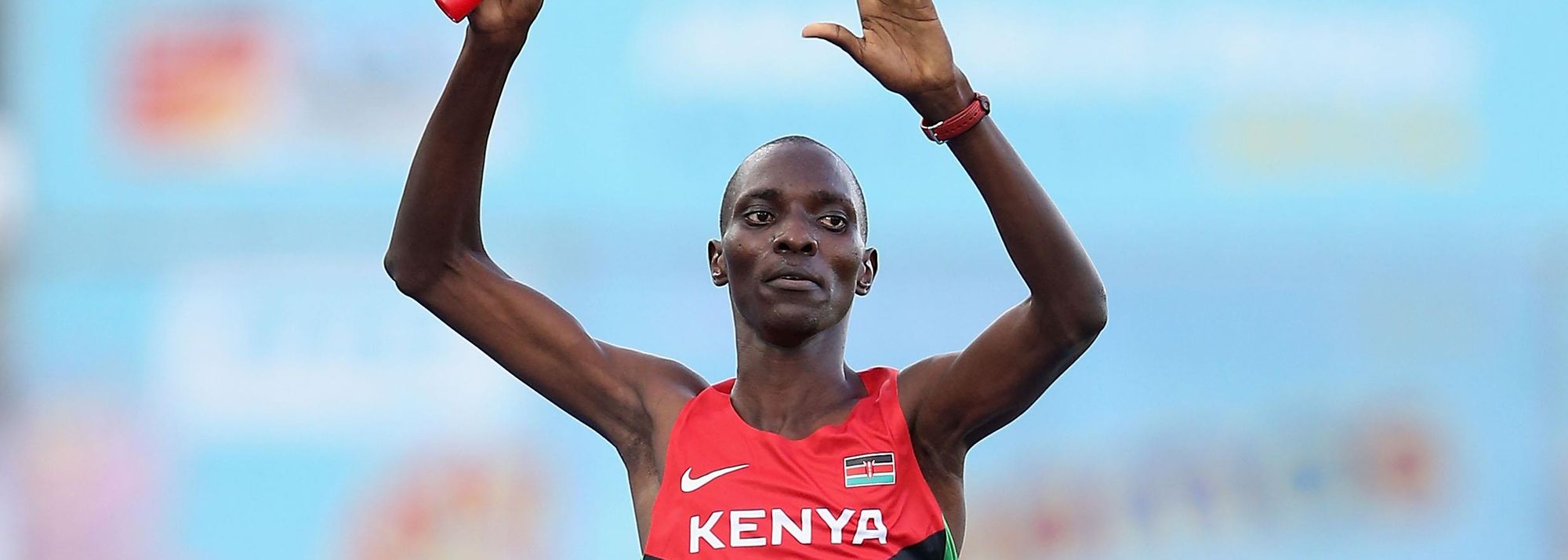Asbel Kiprop of Kenya celebrates after winning and setting a world record of 14:22.22 in the men's 4x1500m relay (© Getty Images)
it was widely agreed that Kenya was fully capable of breaking the men’s 4x1500m world record at the IAAF World Relays but, unlike in the women's event which had been relatively rarely run at international level before this year, most pundits stopped short of calling the men's mark a certainty.
They need not have been so cautious.
The standing mark prior to Nassau 2014 of 14:36.23, set by Kenya in 2006, required an average carry of just under 3:40 but Kenya's team – Collins Cheboi (personal best of 3:31.53), Silas Kiplagat (3:29.27), James Magut (3:30.61) and Asbel Kiprop (3:27.72) – were all well capable of running within that time with room to spare.
The end result was not quite so dramatic as the 32-second demolition job the Kenyan women’s team did on their mark on Saturday, but Cheboi, Kiplagat, Magut and Kiprop – with splits of 3:38.60, 3:32.50, 3:38.80 and 3:32.30 – were all under that magic average and took 14 seconds off the old record and move the goal posts.
The new mark, 14:22.22, will now require four men to average just over 3:35 to beat it.
Mission not impossible
"We had a mission today," acknowledged Kiplagat. "To win and break the world record."
Like the women, the new mark, while a clear improvement, is still very attainable, particularly for Kenyan quartets; Kenya has six men under 3:35 already this year.
However, there's more to the attainability of the record than just addition; there's also strategy.
The uneven pacing of Sunday's record, with Cheboi and Magut running 3:38 and Kiplagat and Kiprop well under that, suggests that another successful attempt might benefit from a redistribution of effort and stronger rivals in the race.
The Kenyans almost had that competition this time.
The Ethiopians, led by Mekonnen Gebremedhin, set the pace for the first three laps, and the USA's Patrick Casey was the first to the 1500m exchange.
If Kiplagat was going to run 3:32 anyway, what if Magut had run his leg with the USA's second leg, David Torrence, on his shoulder?
Torrence ran 3:36.60 and covered his first lap in 54 seconds; Magut's first full 400m split was a 58. It's clear that quite a bit of room remains for the Kenyans to push the mark even faster.
Kiprop, who watched the whole thing from the bottom of the first bend, seemed to be watching someone else's race, and his analytical viewpoint showed in his post-race comments.
"The times were not that fast in the beginning, but we managed to break it," said Kiprop, who admitted he was so lost in his calculations of the splits that he nearly missed his handoff, surprised to find Magut coming around the bend to hand off the baton.
The team is rightly proud of what they did accomplish.
More to come
"I am really happy to be part of this world record-breaking team," said Magut. "You can expect more from Kenya."
An additional mark of the relatively tougher challenge the 4x1500m men faced was that unlike the women, no teams other than the winners dipped under the old record.
The US runners-up were still four seconds adrift of the old mark but are now fourth on the all-time list behind a 1977 German team and a 1973 New Zealand quartet.
"It is an amazing feeling," said Cheboi, who unlike Kiprop and Kiplagat has not had the experience of racing at an IAAF World Championships or Olympics Games. "The crowd was amazing and they encouraged us all the way through."
The love between the Kenyans and the crowd appeared to be mutual. Perhaps it was the music; for both of the long relays, the junkanoo band on the first bend was playing, banging and dancing ecstatically.
As the Kenyans took their lap of honour, they too almost seemed to be dancing, particularly as they approached the section on the backstretch packed with yellow-and-green Jamaican flags.
It might be asking a lot for distance runners to race over 5000m or 10,000m in the heat of the Caribbean, but cover 6000m in a relay, fill the stadium with Bahamians and Jamaicans, and you have all the ingredients for a race the likes of which has never happened before.
Parker Morse for the IAAF




